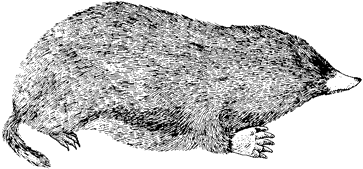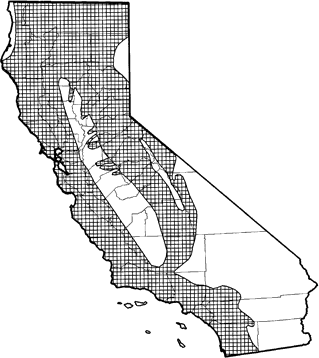
Broad-footed Mole
Distribution, Abundance, and Seasonality
The broad-footed mole is common in most of California except the hot deserts and portions of the Central Valley. Optimal habitats are annual and perennial grassland, pasture, montane and valley foothill riparian, and aspen. Also occurs in cropland, orchard-vineyard, wet meadow, and a variety of open forest habitats. Occurs from nearly sea level to 2970 m (9500 ft).

Range Map
Specific Habitat Requirements
Feeding: Important foods include earthworms, insects (adults, larvae, and pupae), spiders, centipedes, and some plant food. Occasionally eats small mammals, crustaceans, and seeds. Feeds just below the ground surface by burrowing. Detects some prey by feeling vibrations in the soil. May feed at deeper levels when conditions are dry or cold.
Cover: Largely subterranean, requiring friable soil for burrowing.
Reproduction: Makes a nest of grass and leaves in an additional tunnel, greater than 0.3 m (1 ft) deep.
Water: No data found.
Pattern: Prefers moist, friable soils. Avoids flooded soils. Most common in moist meadows and near streams.
Species Life History
Activity Patterns: Active yearlong, intermittently day and night. Especially active after rain, probably in response to increased activity of prey, and easier digging.
Seasonal Movements / Migration: Moves away from flooded areas. May move into chaparral, or other dry habitats, when conditions are moist.
Home Range: Home range consists of a tunnel system. No data found on home range size for this species. The similar European mole (Lund 1976) had a home range of 0.02 to 0.2 ha (0.05 to 0.5 ac), depending on food availability. The eastern mole had a home range of 0.3 to 1.1 ha (0.75 to 2.75 ac) (Yates and Pedersen 1982). The broad-footed mole may travel at the rate 5.5 m (18 ft) per hr after rains.
Territory: Moles are highly territorial, defending and patrolling the burrow system. This species probably is solitary, except when mating or caring for young.
Reproduction: Breeds from February to May (Jackson 1915). The single yearly litter ranges from 2-5, with an average of 4 young. Lactation lasts from 30-35 days. Young leave the nest in June.
Niche: Predators include owls. This species does not occur with other moles in California. Moles may play an important role in soil development through their burrowing activities.
Sources & References
California Department of Fish and Game, 1999.
California's Wildlife, Sacramento, CA.
Written by: J. Harris, reviewed by: H. Shellhammer, edited by: S. Granholm
Giger, R. D. 1973. Movements and homing in Townsend's mole near Tillamook, Oregon. J. Mammal. 54:648-659. Grim, J. N. 1958. Feeding habits of the southern California mole, Scapanus latimanus occultus. J. Mammal. 39:265-268. Grinnell, J., and H. S. Swarth. 1912. The mole of southern California. Univ. Calif. Publ. Zool. 10:131-136. Grinnell, J., and T. I. Storer. 1924. Animal life in the Yosemite. Univ. California Press, Berkeley. 752pp. Jackson, H. H. T. 1915. A review of the American moles. U.S. Dep. Agric., North Amer. Fauna No. 38. 98pp. Lund, M. 1976. Control of the European mole, Talpa europaea. Vertebr. Pest Conf. Proc. 7:125-130. Palmer, F. G. 1937. Geographic variation in the mole Scapanus latimanus. J. Mammal. 18:280-314. Scheffer, T. H. 1923. American moles as agricultural pests and as fur producers. USDA., Farmers Bull. No. 1247. 23pp. Scheffer, T. H. 1949. Ecological comparisons of three genera of moles. Trans. Kans. Acad. Sci. 52:30-37. Storer, T. I., and R. L. Usinger. 1963. Sierra Nevada natural history. Univ. California Press, Berkeley. 374pp. Yates, T. L., and R. J. Pedersen. 1982. Moles. Pages 37-51 in J. A. Chapman and G. A. Feldhamer, eds. Wild mammals of North America. Johns Hopkins Univ. Press, Baltimore, MD. 1147pp.
California Animal Facts | California's Wildlife